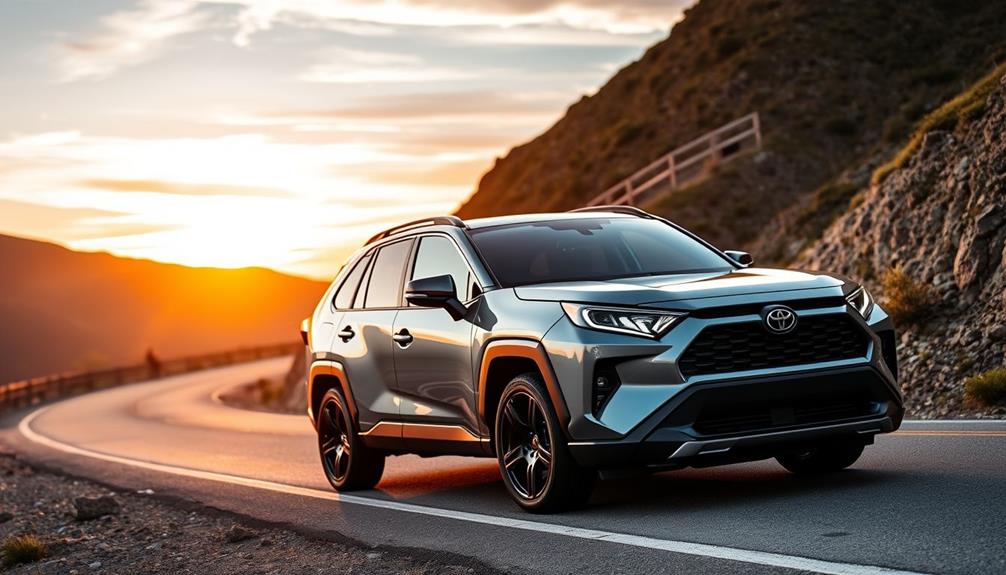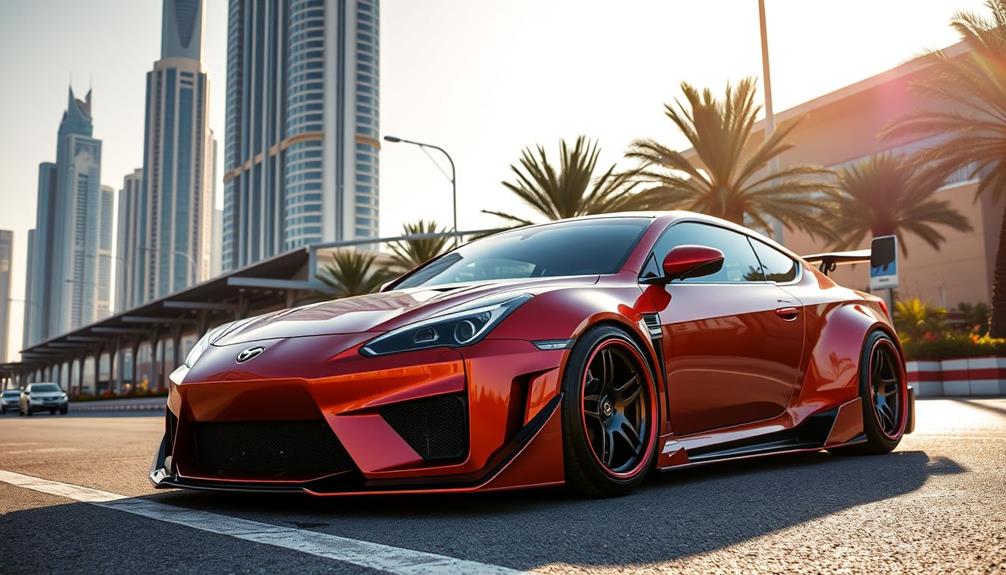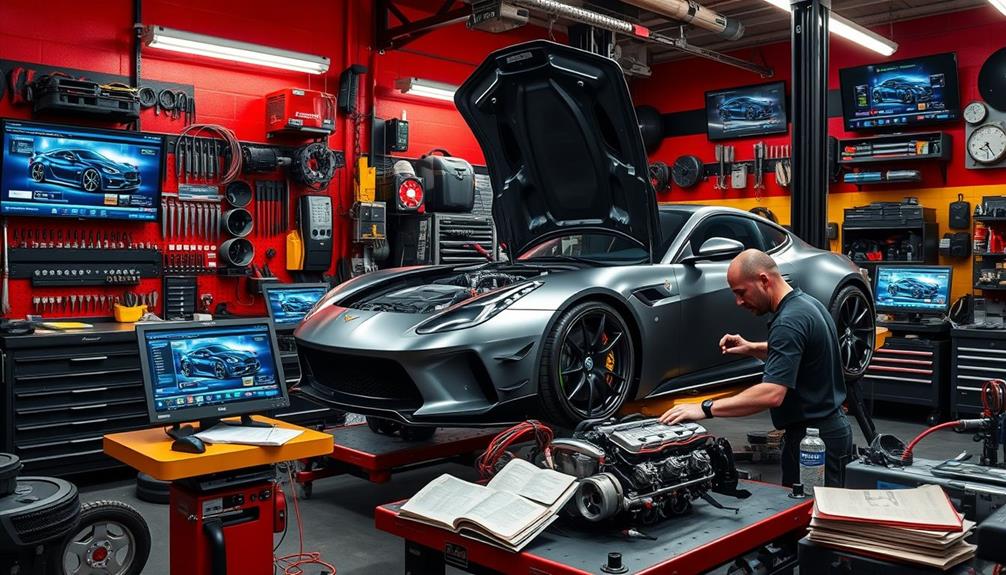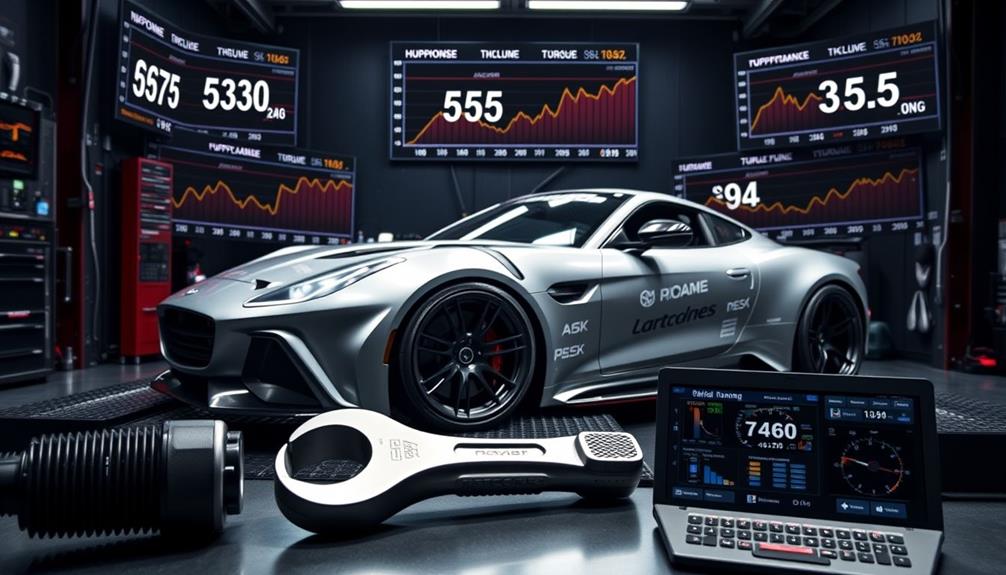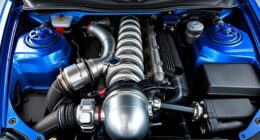To fix a car tune-up like a pro, start by inspecting key components such as spark plugs, ignition wires, and air filters. Replace spark plugs every 60,000 to 120,000 miles to avoid misfires. Pay attention to the check engine light; it could signal ignition or fuel issues. Look for unusual noises or fluid leaks that might indicate other problems. Regularly monitor fluid levels, including engine oil and coolant, to prevent wear. By staying proactive with these steps, you'll maintain peak performance. If you need tips on addressing specific warning lights or other common issues, stick around for more insights. For more in-depth assistance with car tune-ups, consider utilizing car tuning resources such as online forums, instructional videos, or consulting with a trusted mechanic. These resources can provide valuable insights and guidance for addressing specific issues and performing more advanced tune-up tasks. Stay informed and empowered to keep your car running smoothly for years to come.
Key Takeaways
- Inspect and replace spark plugs every 60,000 to 120,000 miles to prevent misfires and ensure smooth engine performance.
- Check ignition wires for wear or damage, as they can cause rough idling or starting issues.
- Regularly clean or replace air filters to maintain optimal fuel efficiency and engine performance.
- Monitor fluid levels, including engine oil and coolant, to prevent overheating and engine damage.
- Use an OBD-II scanner to diagnose and address warning lights promptly, preventing severe vehicle issues.
Understanding Tune-Up Essentials
A tune-up is essential for keeping your car running smoothly and efficiently. It primarily involves inspecting and replacing key components like spark plugs, ignition wires, and air filters to maintain optimal engine performance. Regular tune-ups can enhance fuel efficiency and extend your vehicle's lifespan by addressing minor issues before they turn into major problems.
Manufacturers typically recommend performing tune-ups every 15,000 to 100,000 kilometers, depending on your vehicle's age and model. During this routine maintenance, you'll want to check and replace air filters to guarantee clean airflow, as well as inspect fluids for contamination to prevent excessive engine wear.
The ignition system plays an important role in your car's operation, so replacing spark plugs and ignition coils during a tune-up is essential for preventing misfires and guaranteeing smooth performance.
If you're not comfortable performing these tasks yourself, it's wise to consult a professional mechanic who can handle the details for you. By staying on top of your tune-ups, you greatly improve your vehicle's fuel efficiency and overall engine performance, keeping your ride reliable for years to come.
Diagnosing Common Issues

When diagnosing common issues during a tune-up, start by paying attention to your vehicle's check engine light. This light can signal various problems, particularly with the ignition and fuel system. Next, perform a visual inspection of your spark plugs. Look for signs of wear or fouling, which may indicate misfires or poor engine performance.
While checking the engine, listen for unusual noises like clunking or popping. These sounds could point to issues with ignition timing or fuel delivery. Additionally, check for fluid leaks under your vehicle. Identifying the type of fluid can help you pinpoint potential problems in systems like cooling, braking, or power steering.
Lastly, monitor your tire condition. Uneven wear patterns might suggest alignment issues that can compromise handling and safety if left unaddressed.
Here's a quick reference table to help you identify common issues:
| Symptoms | Possible Issues |
|---|---|
| Check Engine Light | Ignition/Fuel System Faults |
| Worn/Fouled Spark Plugs | Misfires/Performance Issues |
| Unusual Noises | Ignition Timing/Fuel Delivery |
| Fluid Leaks | Cooling/Braking Problems |
| Uneven Tire Wear | Alignment Issues |
Regular maintenance can prevent these problems!
Key Components to Inspect

Regularly inspecting key components of your vehicle during a tune-up can make a significant difference in performance and longevity. Start with the spark plugs; they should typically be replaced every 60,000 to 120,000 miles to prevent misfires that can hurt engine performance.
Next, check the ignition wires for any signs of wear or damage, as faulty wires can lead to rough idling and reduced efficiency.
Don't overlook the air filter; verify it's clean and replace it at the recommended intervals. A dirty air filter can drastically decrease fuel economy and engine performance.
Additionally, inspect the belts and hoses for fraying, cracking, or leaks. Neglecting these can result in catastrophic engine damage that's costly to repair.
Lastly, regularly monitor fluid levels and conditions, including engine oil, coolant, and brake fluid. Keeping these fluids at appropriate levels helps prevent excessive wear and costly repairs down the line.
Addressing Warning Lights

Warning lights on your dashboard are vital indicators of your vehicle's health, and addressing them promptly can save you from expensive repairs down the line.
When the Check Engine light appears, it can signify various issues, such as problems with the ignition system, fuel system, or emissions control. Use an OBD-II scanner to retrieve the specific Diagnostic Trouble Codes (DTCs) related to the light.
Oil pressure warning lights may indicate low oil levels or pressure issues, so check your oil levels immediately and look for potential leaks.
The tire pressure warning light alerts you to insufficient tire inflation, which can impact fuel efficiency and safety. Regularly checking tire pressures is essential for proper maintenance.
If the engine temperature light comes on, it warns you of potential overheating. Take immediate action to check your coolant levels and inspect the cooling system for leaks or failures.
Ignoring these illuminated warning lights can lead to severe vehicle issues and costly repairs. By addressing these alerts promptly, you guarantee your vehicle's health and maintain its performance through regular tune-ups and proper maintenance items.
Maintaining Optimal Performance

Maintaining Ideal Performance
Addressing warning lights is just the beginning of keeping your vehicle running smoothly; maintaining peak performance requires a proactive approach to routine care. Start by regularly inspecting and replacing spark plugs every 60,000 to 120,000 miles. This guarantees ideal ignition and prevents misfires that can compromise engine performance.
Additionally, just as with keeping your vehicle in prime condition, staying aware of your health is significant, especially when considering cold medications overview to avoid unnecessary complications during cold season.
Next, keep your air filters clean. A dirty air filter can reduce fuel efficiency by up to 10%, affecting how well your engine runs. Make it a habit to check and replace essential fluids like engine oil, coolant, and transmission fluid at the manufacturer's recommended intervals to avoid excessive wear and potential engine damage.
Don't forget about the belts and hoses! Pay special attention to timing belts, which typically require replacement every 80,000 to 100,000 miles. Neglecting this can lead to catastrophic engine failure.
Frequently Asked Questions
Can Not Getting a Tune-Up Mess up Your Car?
Yes, not getting a tune-up can definitely mess up your car. You'll experience rough idling, decreased fuel efficiency, and increased emissions, leading to costly repairs and reduced engine performance. Regular maintenance keeps everything running smoothly.
What Is the Main Item to Be Replaced During a Tune-Up?
You might think a tune-up is just routine, but the main item to replace is spark plugs. They're essential for ideal engine performance, so changing them every 60,000 to 100,000 miles keeps your ride smooth.
How Does a Car Act When It Needs a Tune-Up?
When your car needs a tune-up, you might notice difficulty starting, frequent stalling, strange sounds while idling, decreased fuel economy, or it may reach the recommended mileage for maintenance. Don't ignore these signs!
How Do I Figure Out What's Wrong With My Car?
To figure out what's wrong with your car, visually inspect for leaks and worn parts, monitor warning lights, listen for unusual noises, and check fluid levels. Regular tire checks can also help identify issues.
Conclusion
In summary, tackling your car's tune-up can feel like a dance—each step matters. By understanding the essentials and diagnosing common issues, you can keep your ride smooth and reliable. Remember, inspecting key components and addressing warning lights isn't just maintenance; it's a commitment to your vehicle's performance. So, roll up your sleeves, get hands-on, and watch your car transform from a clunky machine to a well-oiled masterpiece. You've got this!

